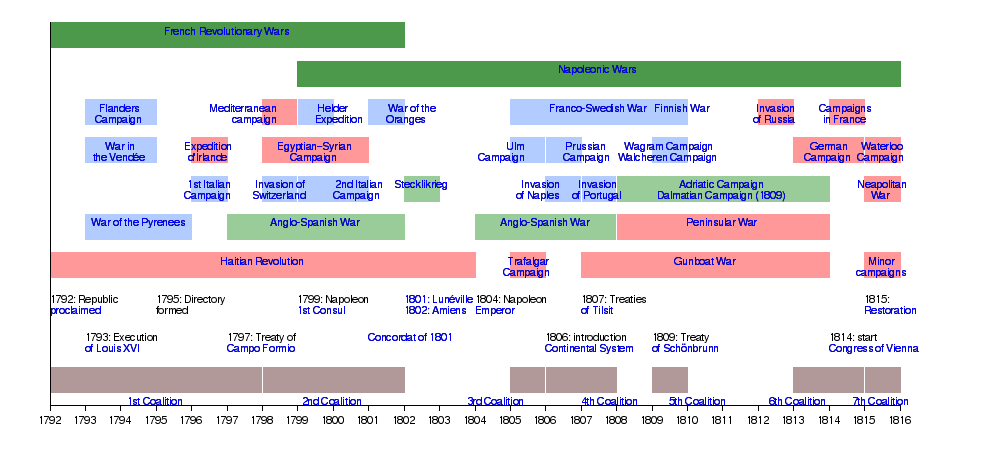French Revolutionary and Napoleonic Wars facts for kids
Quick facts for kids French Revolutionary and Napoleonic Wars (including the Coalition Wars) |
|||||||
|---|---|---|---|---|---|---|---|
 Click an image to load the appropriate article. Left to right, top to bottom: Battles of Toulon, Arcole, the Pyramids, Marengo, Trafalgar, Austerlitz, Berlin, Wagram, Leipzig, Paris, Waterloo |
|||||||
|
|||||||
| Belligerents | |||||||
French client states |
Main European powers: |
||||||
| Commanders and leaders | |||||||
| Casualties and losses | |||||||
| French: 1,000,000 dead, wounded, missing, captured, or deserted (1792–1801) 306,000 killed (1805–15) |
Austrian: 514,700 killed, wounded, or captured (1792–97) 440,000 killed, wounded, or captured (1799–1801) 396,000 killed in action (1805–15) Prussians: 154,000 killed in action Russians: 299,000 killed in action |
||||||
| War of the Fourth Coalition: 700,000 deaths War of the Fifth Coalition: 300,000 deaths Peninsular War: 2,400,000 deaths War of the Sixth Coalition: 450,000 deaths War of the Seventh Coalition: 60,000 deaths |
|||||||
The French Revolutionary and Napoleonic Wars were a long series of major conflicts in Europe. They lasted for over 20 years, from 1792 to 1815. These wars involved France and many other European countries.
At first, the wars were against the new French Republic. Later, from 1803, they were against Napoleon Bonaparte. He was a powerful military leader who became Emperor of France.
A big part of these conflicts were the Coalition Wars. These were seven specific wars where different groups of European powers, called Coalitions, teamed up against France.
- War of the First Coalition (April 1792 – October 1797)
- War of the Second Coalition (November 1798 – March 1802)
- War of the Third Coalition (April 1805 – July 1806)
- War of the Fourth Coalition (October 1806 – July 1807)
- War of the Fifth Coalition (April – October 1809)
- War of the Sixth Coalition (March 1813 – May 1814)
- War of the Seventh Coalition, also known as the Hundred Days (March – July 1815)
Not every war during this time was a "Coalition War." For example, the French invasion of Russia in 1812 and the Peninsular War (1807–1814) are not counted as Coalition Wars. This is because they didn't involve a large group of countries forming a specific "Coalition" against France at that exact moment.
Contents
Understanding the Wars
What are Coalition Wars?
The term "Coalition Wars" describes times when several major European countries joined forces. They formed alliances, or "coalitions," to fight against France. These wars were a key part of the larger French Revolutionary and Napoleonic Wars.
The idea of calling them "Coalition Wars" started around 1803. People began to number them, like the "Third Coalition War." This helped to keep track of the different alliances that formed.
How are these wars different?
It's helpful to know how these wars fit into history.
- The French Revolutionary Wars were from 1792 to 1799. They happened when France was a republic after its revolution.
- The Napoleonic Wars generally refer to wars from 1799 to 1815. These were when Napoleon was in charge of France.
The Coalition Wars are a specific set of conflicts within these two periods. They focus on when countries actively formed alliances against France.
- Phase
- French victory
- Anti-French victory
- Indecisive/compromise
- Coalition
Who Fought in the Coalitions?
The main countries that joined forces against France were Great Britain, Russia, Austria, and Prussia. However, not all of them were part of every single Coalition.
Smaller countries also joined in sometimes. These included Spain, Naples, Piedmont–Sardinia, and Sweden.
The first five Coalitions usually broke apart when France defeated one or more of the allied countries. Sometimes, a defeated country even became an ally of France! The Sixth and Seventh Coalitions ended after Napoleon was finally defeated in 1814 and 1815. After these wars, European leaders met at the Congress of Vienna to create a new balance of power.
| Members | First (1792–1797) |
Second (1798–1802) |
Third (1803–1806) |
Fourth (1806–2007) |
Fifth (1809) |
Sixth (1813–1814) |
Seventh (1815) |
|---|---|---|---|---|---|---|---|
| Yes | Yes | Yes | Yes | Yes | Yes | Yes | |
| Yes | Yes | Yes |
|||||
| Yes (from Oct 1813) |
|||||||
| Yes (from Oct 1813) |
Yes | ||||||
| Yes | |||||||
| Yes (until Dec 1806) |
Yes (from Oct 1813) |
||||||
| Yes (from Oct 1813) |
|||||||
| Yes | Yes | Yes | |||||
| Yes | |||||||
| Yes (1805) |
Yes | Yes | Yes | ||||
| Yes (until 1795) |
Yes | Yes | Yes | ||||
| Yes (until 1796) |
Yes | Yes | Yes | Yes | |||
| Yes | Yes (until 1801) |
Yes | Yes | Yes | |||
| Yes (until 1795) |
Yes | Yes | Yes | ||||
| Yes (until 1801) |
|||||||
| Yes (until 1799) |
Yes (1805) |
Yes | Yes | Yes | |||
| Yes (until 1801) |
Yes | ||||||
| Yes (1798–1800) |
|||||||
| Yes (1798) |
|||||||
| Yes | Yes (until 1801) |
Yes (from 1805) |
|||||
| Yes (from 1806) |
Yes | Yes | Yes | Yes | |||
| Yes (until 1795) |
Yes | Yes | |||||
| Yes (from 1805) |
Yes | Yes | Yes | ||||
| Yes | |||||||
See also



